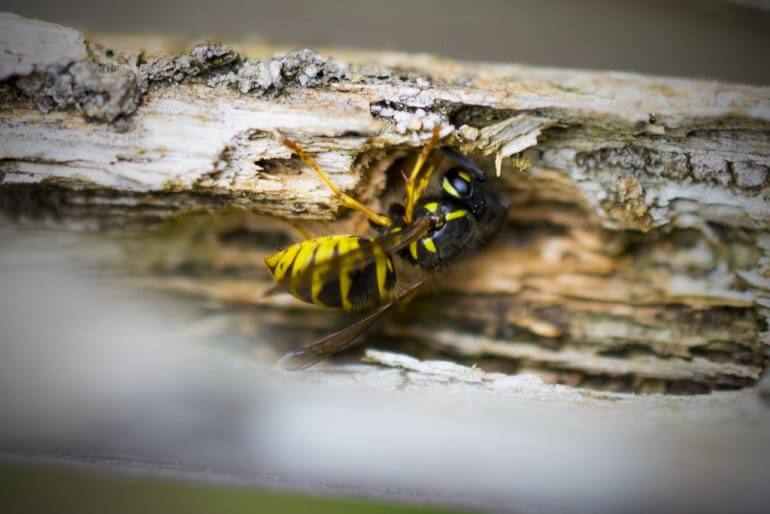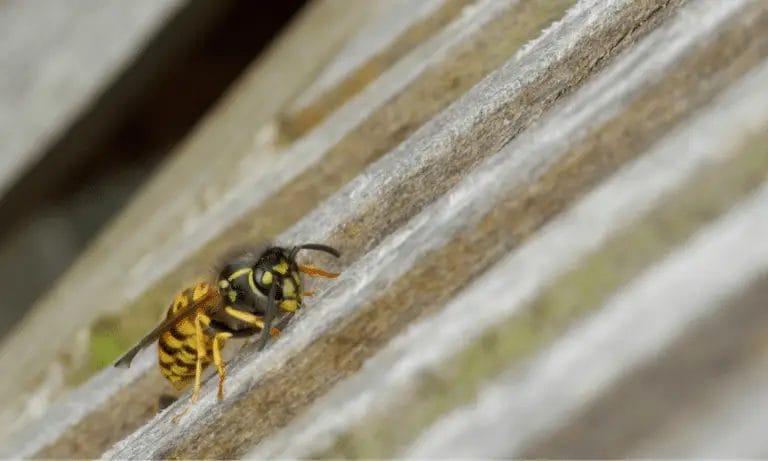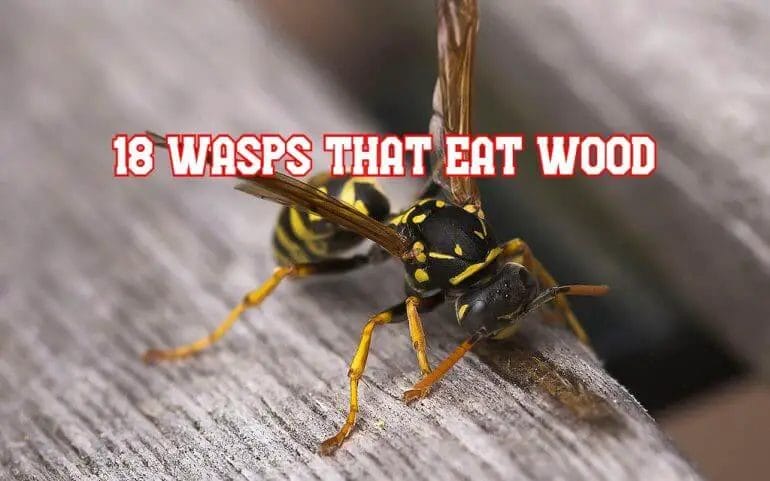Yes, wasps do eat wood. Wood-eating wasps, known as woodwasps or horntails, have larvae that burrow into trees and feed on the wood. These wasps play an important role in nature by decomposing dead wood and aiding in nutrient recycling. However, it’s important to note that not all wasps eat wood. Most species of wasps feed on nectar, pollen, insects, or other food sources.

The Significance of Wood in the Life Cycle of Wasps
Wasps are fascinating creatures that play important roles in various ecosystems. They are known for their ability to build intricate nests, typically made from wood fibers and saliva. In this section, we will explore the significance of wood in the life cycle of wasps and how it contributes to their survival and reproduction.

1. Nest Construction:
Wood plays a crucial role in the nest construction process of many wasp species. Female wasps chew and gather wood fibers from various sources, such as tree bark or dead wood, to create a papery pulp. They mix this pulp with their saliva to form a durable material for building their nests. The use of wood in nest construction provides wasps with a sturdy and protective structure.
2. Protection and Camouflage:
The use of wood in nest construction not only provides protection for wasps but also helps with camouflage. Many wasp species create nests that blend seamlessly with their surroundings, making it difficult for predators to detect them. The color and texture of the wood used in nest construction play a crucial role in enhancing this camouflage.
3. Larval Development:
Wood also plays a significant role in the development of wasp larvae. After a female wasp has constructed her nest, she lays eggs within individual cells made from wood pulp. These cells serve as protective chambers for the developing larvae. The wood material provides insulation and acts as a barrier against temperature fluctuations, ensuring optimal conditions for the larvae to grow and develop.
4. Nutritional Source:
Certain wood-boring wasp species rely on wood as a primary nutritional source. These wasps lay their eggs directly within the wood, and the developing larvae feed on the wood as they grow. They have specialized enzymes that help them break down the wood fibers and extract the nutrients they need for their development. This unique adaptation allows these wasps to utilize a resource that is abundant but often inaccessible to other organisms.
5. Decomposition and Nutrient Cycling:
Wasps that utilize wood in their life cycle also contribute to the decomposition and nutrient cycling processes in ecosystems. As they chew and gather wood fibers for nest construction, they may inadvertently aid in breaking down dead wood and returning nutrients back into the environment. This process is essential for maintaining a healthy ecosystem and facilitating the recycling of organic matter.
In summary, wood plays a critical role in the life cycle of wasps. It is used for nest construction, providing protection, camouflage, and a suitable environment for larval development. Certain wood-boring wasp species even rely on wood as a nutritional source. Additionally, the activities of wasps that utilize wood contribute to decomposition and nutrient cycling in ecosystems. Understanding the significance of wood in the life cycle of wasps helps us appreciate the intricate relationships and roles these fascinating insects play in our natural world.

Wood-destroying wasps: Types and behavior
Wood-destroying wasps are a group of insects that can cause significant damage to wooden structures. These wasps have specialized behaviors that allow them to tunnel into wood, creating nests and galleries for their offspring. In this section, we will explore the different types of wood-destroying wasps and discuss their behavior in detail.
1. Carpenter Bees
Carpenter bees are large-bodied insects that resemble bumblebees. They are known for their ability to excavate tunnels in wooden structures, such as decks, fences, and eaves. Female carpenter bees bore perfectly round holes into the wood, typically around half an inch in diameter. These holes serve as entrances to their nests, which consist of a series of galleries where they lay their eggs and rear their young.
Unlike many other wood-destroying insects, carpenter bees do not consume wood for nutrition. Instead, they feed on nectar and pollen from flowers. However, their tunneling activities can weaken wooden structures, leading to potential structural damage over time.
2. Horntails
Horntails, also known as wood wasps or wood-boring wasps, belong to the family Siricidae. These wasps have a distinctive appearance, with long, thin bodies and a characteristic “tail” or ovipositor that protrudes from the abdomen. Female horntails use their ovipositors to drill into wood and lay their eggs.
Once inside the wood, horntail larvae feed on the cellulose present in the plant fibers. As they grow, they create tunnels or galleries within the wood, which can weaken its structural integrity. Horntails are particularly attracted to freshly cut or damaged wood, making them a potential threat to lumberyards and recently constructed wooden structures.
3. Powderpost Beetles
Powderpost beetles are a group of wood-boring insects that belong to the family Bostrichidae. These beetles are known for their ability to reduce wood to a fine, powdery substance. They typically infest hardwoods, such as oak, hickory, and mahogany.
Female powderpost beetles lay their eggs on or inside cracks and crevices of wood. Once the eggs hatch, the larvae burrow into the wood and feed on the wood’s starch content. As they tunnel through the wood, powderpost beetle larvae create a network of galleries, eventually reducing the wood to a powdery substance.
4. Carpenter Ants
Carpenter ants are not wasps, but they are included in this section because of their destructive behavior towards wood. These ants do not eat wood, but they excavate galleries within it to create nests. They are typically attracted to damp or decaying wood, which provides them with a suitable environment for nesting.
Carpenter ants can cause significant damage to wooden structures, as their galleries weaken the integrity of the wood. Signs of a carpenter ant infestation include small piles of sawdust-like debris (known as frass) and the presence of swarmers (winged reproductive ants) during mating season.
Summary:
Wood-destroying wasps, including carpenter bees, horntails, powderpost beetles, and carpenter ants, can cause damage to wooden structures. These insects have specialized behaviors that allow them to tunnel into wood, creating nests and galleries for their offspring. Understanding the types and behaviors of wood-destroying wasps is essential for effective pest management and the preservation of wooden structures.

Damage caused by wood-eating wasps: Prevention and control measures
Wood-eating wasps are a common pest that can cause significant damage to homes and structures. These wasps, also known as carpenter wasps, burrow into wooden structures and create nests, leading to weakened structures and potential safety hazards. In this section, we will explore the damage caused by wood-eating wasps and discuss effective prevention and control measures to mitigate their impact.
1. Damage caused by wood-eating wasps
Wood-eating wasps primarily target wooden structures and materials such as decks, fences, eaves, and even furniture. Their burrowing activity weakens the integrity of the wood, causing structural damage and potential safety risks. Here are some common signs of wood-eating wasp infestation:
- Small round exit holes on wooden surfaces
- Powdery frass or sawdust around the exit holes
- Visible burrows or tunnels in the wood
- Weakened or sagging structures
- Wood decay and rot
It is important to address wood-eating wasp infestations promptly to prevent further damage and ensure the safety of the affected structures.
2. Prevention measures
Prevention is key when it comes to controlling wood-eating wasp infestations. By implementing the following measures, you can reduce the risk of damage:
- Regular inspection: Conduct routine inspections of wooden structures for any signs of infestation or damage. Early detection can help prevent the problem from worsening.
- Seal cracks and crevices: Seal any gaps or openings in wooden surfaces to prevent entry points for wood-eating wasps.
- Keep wood dry: Moisture attracts wood-eating wasps. Ensure proper ventilation and drainage to keep wooden structures dry.
- Use treated wood: Consider using pressure-treated or naturally resistant wood for construction projects, as they are less prone to wood-eating wasp infestations.
- Remove decaying wood: Remove any decaying or rotting wood from your property, as it attracts wood-eating wasps.
3. Control measures
If wood-eating wasps have already infested your property, it is essential to take immediate control measures to prevent further damage. Here are some effective control methods:
- Professional pest control: Contact a licensed pest control professional who specializes in wood-eating wasp removal and control. They have the expertise and necessary tools to safely eliminate the infestation.
- Chemical treatments: In severe infestations, chemical treatments may be required. It is crucial to follow the instructions provided by the manufacturer and take appropriate safety precautions.
- Traps: Wood-eating wasp traps can be used to capture and control the population. These traps should be strategically placed near infested areas.
- Physical exclusion: Seal off any access points by repairing damaged wood or applying fine mesh screens to prevent wood-eating wasps from entering structures.
It is important to note that before implementing any control measures, it is advisable to consult with a professional pest control expert to determine the most appropriate course of action based on the severity of the infestation.
Summary
Wood-eating wasps can cause significant damage to wooden structures if left unaddressed. Regular inspections, sealing cracks, keeping wood dry, using treated wood, and removing decaying wood are effective prevention measures. In cases of infestation, professional pest control, chemical treatments, traps, and physical exclusion can help control the wood-eating wasp population. By implementing these prevention and control measures, you can protect your property from the damaging effects of wood-eating wasps.
Coexistence with wood-eating wasps: Tips for managing their presence safely
Wood-eating wasps, also known as wood-boring wasps, are a common sight in many outdoor spaces. While they may seem intimidating, these insects play an essential role in the natural ecosystem by helping to break down dead and decaying wood. However, when wood-eating wasps invade our homes or pose a threat to human safety, it becomes necessary to manage their presence. In this section, we will provide some tips on coexisting with wood-eating wasps and managing their presence safely.
1. Identify the species
Before taking any action, it is crucial to correctly identify the species of wood-eating wasps present. This knowledge will help determine the level of threat they pose and the appropriate management strategies to employ. Some wood-eating wasp species are harmless, while others can cause damage to wooden structures or sting if provoked.
2. Maintain a safe distance
If wood-eating wasps are present in your outdoor space, it is best to maintain a safe distance and avoid direct contact with their nests or the affected area. These insects are usually docile and will not attack unless they feel threatened. By giving them space, you reduce the risk of accidental stings or disturbances that may lead to defensive behavior.
3. Seal cracks and crevices
Wood-eating wasps often enter homes through small cracks and crevices. To prevent their entry, it is recommended to seal any openings in windows, doors, or walls to deny them access. Additionally, regular inspection and maintenance of wooden structures can help identify and address any potential vulnerabilities that may attract these insects.
4. Remove attractants
Wood-eating wasps are attracted to decaying wood, so removing or properly disposing of any rotting logs, stumps, or fallen trees from your property can help deter them. It is also important to keep firewood elevated and away from your home to avoid providing a potential nesting site.
5. Consult a professional
If the presence of wood-eating wasps becomes a persistent problem or poses a significant threat to human safety, it is advisable to consult a pest control professional. They have the knowledge and resources to safely remove or manage the infestation, ensuring the well-being of both humans and the environment.
6. Educate and raise awareness
Increasing awareness about wood-eating wasps and their ecological importance can help foster a better understanding and appreciation for these creatures. By educating others about the benefits they provide to the ecosystem, we can promote a more harmonious coexistence and reduce unnecessary fear or harm towards wood-eating wasps.
Summary
Wood-eating wasps are an integral part of the natural ecosystem, but their presence can sometimes pose challenges. By properly identifying the species, maintaining a safe distance, sealing cracks and crevices, removing attractants, consulting professionals if needed, and raising awareness, we can manage their presence safely and coexist harmoniously with these fascinating insects.
FAQs
Do wasps eat wood?
No, wasps do not eat wood. However, certain species of wasps, like the carpenter wasp, can chew through wood to create nests or tunnels.
Can wasps sting multiple times?
Yes, unlike bees, most wasp species can sting multiple times without losing their stinger. This makes them more aggressive and potentially more dangerous.
How can I prevent wasps from nesting near my house?
To prevent wasps from nesting near your house, seal any openings or cracks in walls, roofs, or windows. Remove potential food sources and keep your garbage cans tightly sealed. If necessary, seek professional help to remove existing wasp nests.
Conclusion:
In conclusion, while wasps are not known for consuming wood, certain species such as the carpenter wasps can indeed damage wooden structures. These particular wasps excavate tunnels in wood to create their nests, causing potential damage to buildings, fences, or wooden furniture. However, it is important to note that not all wasps engage in wood-eating behavior. It is also crucial to properly identify the wasp species and assess the extent of the damage before taking any preventive or control measures.
Understanding the habits and behavior of wasps is essential for effective pest management. Taking preventive measures such as sealing cracks and crevices, maintaining a clean and tidy environment, and seeking professional help when necessary can help minimize the risk of wood damage caused by wasps.
In summary, while not all wasps eat wood, some species can pose a threat to wooden structures. By staying informed and implementing appropriate precautions, homeowners can protect their property and maintain a wasp-free environment.